
Sciaenidae is a family of ray-finned fishes belonging to the order Acanthuriformes. They are commonly called drums or croakers in reference to the repetitive throbbing or drumming sounds they make. The family consists of about 293 to 298 species in about 66 or 67 genera.
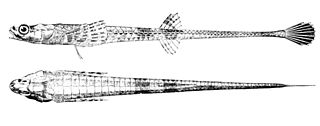
Agonidae is a family of small, bottom-dwelling, cold-water marine fish. Common names for members of this family include poachers, Irish lords, sea ravens, alligatorfishes, starsnouts, hooknoses, and rockheads. They are notable for having elongated bodies covered by scales modified into bony plates, and for using their large pectoral fins to move in short bursts. The family includes about 59 species in some 25 genera, some of which are quite widespread.

Gasterosteoidei is a suborder of ray-finned fishes that includes the sticklebacks and relatives, the 5th edition of Fishes of the World classifies this suborder within the order Scorpaeniformes.

Hexagrammidae, the greenlings, is a family of marine ray-finned fishes belonging to the suborder Cottoidei in the order Perciformes. These fishes are found in the North Pacific Ocean.

Ephippidae is a family of percomorph fishes, the spadefishes, in the order Moroniformes. These fishes are found in the tropical and temperate oceans of the world, except for the central Pacific.

Congiopodidae, commonly known as pigfishes, horsefishes and racehorses, is a family of ray-finned fish classified with in the order Perciformes. These fishes are native to the Southern Hemisphere.
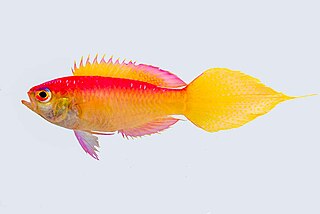
Callanthiidae, the splendid perches and groppos is a small family of marine ray-finned fishes in the order Spariformes. These fishes are mainly found in the Indo-Pacific but two species are found in the eastern Atlantic and Mediterranean.
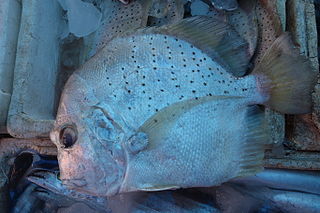
Drepane is a genus of marine and brackish water ray-finned fishes, known commonly as the sicklefishes. It is the only genus in the monotypic percomorph family Drepaneidae. These fish occur in the Indian and western Pacific Oceans, and in the eastern Atlantic near Africa.

Emmelichthyidae is a small family of small to medium-sized marine ray-finned fishes known commonly as rovers, bonnetmouths or rubyfishes.

Argyrosomus is a genus of marine ray-finned fishes belonging to the family Sciaenidae, the drums. The fish in this genus are large and are commonly targeted as game fish.
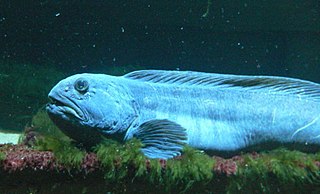
Zoarcoidei is a suborder of marine ray-finned fishes belonging to the order Perciformes. The suborder includes the wolffishes, gunnels and eelpouts. The suborder includes about 400 species. These fishes predominantly found in the boreal seas of the northern hemisphere but they have colonised the southern hemisphere.

Bembridae, the deep-water flatheads, are a family of bottom-dwelling ray-finned fishes. They are found in the Indian and western Pacific Oceans.

Atractoscion is a genus of marine ray-finned fished belonging to the family Sciaenidae, the drums and croakers. The fishes in this genus are found in the Atlantic, Indian and Pacific Oceans.

Acanthuriformes is an order of ray-finned fishes, part of the Percomorpha clade. Some authorities place the fishes in the order within the Acanthuriformes in the suborders Acanthuroidea and Percoidea of the order Perciformes.
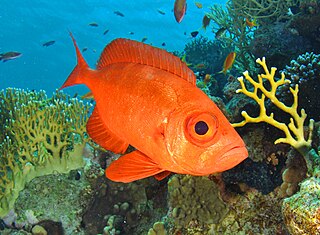
The Priacanthiformes is a proposed order of marine ray-finned fishes. The order comprises two families, the Priacanthidae and the Cepolidae, which bear very little morphological similarity to each other but which have been shown to be sister taxa in repeated molecular analyses. The exact placement of the order within the series Eupercaria is incertae sedis. However, the more traditional classification followed in the 5th Edition of the Fishes of the World places both these families within the order Perciformes.

Siganoidea is a superfamily belonging to the suborder Percoidei which in turn is the largest suborder of the order Perciformes. It contains two families of largely Indo-Pacific distribution.
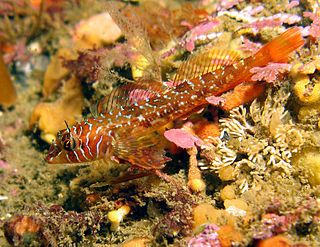
Jordaniidae is a small family of marine ray-finned fishes belonging to the order Perciformes. These fishes are found in the eastern North Pacific Ocean.

Moroniformes is an order of ray-finned fishes in the series Percomorpha.

The geelbeck croaker, also known as the African weakfish or Cape salmon, is a species of marine ray-finned fish belonging to the family Sciaenidae, the drums and croakers. This species is found in the southwestern Indian Ocean off southeastern Africa.
Atractoscion atelodus, the small lunate caudal fin croaker, teraglin, Jew, teraglin-Jew, trag or trag-Jew, is a species of marine ray-finned fish belonging to the family Sciaenidae, the drums and croakers. This species is endemic to the eastern coast of Australia.



















